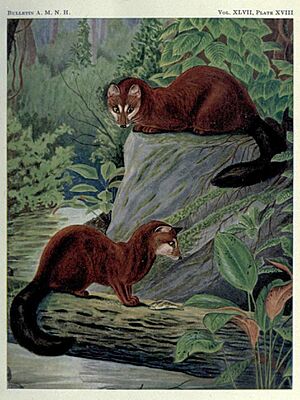Aquatic genet facts for kids
Quick facts for kids Aquatic genet |
|
|---|---|
 |
|
| Conservation status | |
| Scientific classification | |
| Genus: |
Genetta
|
| Species: |
piscivora
|
 |
|
| Aquatic genet range | |
The aquatic genet (Genetta piscivora), also called the fishing genet, is a type of genet. It has only been found in the northeast part of the Democratic Republic of the Congo. This animal is very rare. Scientists only know about 30 specimens in museum collections. Because it is so rare, it was listed as "Data Deficient" on the IUCN Red List in 1996. This means there wasn't enough information about it. In 2015, its status changed to "Near Threatened". This means it might become endangered soon.
When Allen first described the aquatic genet in 1919, he gave it the name Osbornictis piscivora. Later, in 2004, scientists studied its DNA. They found it was actually a type of Genetta species.
Contents
What Makes the Aquatic Genet Special?
Appearance and Unique Features
The aquatic genet has long, thick fur. Its fur is a dark reddish-brown color. It does not have any spots or stripes like other genets. Its head is a light brownish color. It has white spots on the sides of its nose. There are also white spots above and below its eyes. A thin black ring goes around its eyes. The inside of its ears are almost bare. They have long whitish hairs on the edges. The outside of its ears are blackish. Its tail is bushy and black. It has pale brownish fur underneath. The bottoms of its feet are bare. These features are very different from other genet species.
Senses and Adaptations
The aquatic genet's nose area, called a rhinarium, is smaller than other genets. Its olfactory bulbs, which help with smell, are also smaller. This might mean its sense of smell is not very strong. However, its teeth are very sharp. This shows it is good at eating fish, which is called piscivory.
Size and Weight
Two adult male aquatic genets were measured. Their head and body length was about 44.5 to 49.5 cm (17.5 to 19.5 in). Their tails were about 34 to 41.5 cm (13.4 to 16.3 in) long. One male weighed about 1.43 kg (3.2 lb). A female weighed about 1.5 kg (3.3 lb).
Where Do Aquatic Genets Live?
Habitat and Location
Aquatic genets have only been found in rainforests. These forests are east of the Congo River. They are also found in the Tshopo District. They live at elevations from 460 to 1,500 m (1,510 to 4,920 ft) above sea level. There are no confirmed sightings in Uganda. Scientists believe their home range is limited. They likely live in thick evergreen lowland and submontane forests. These forests are found in the Congo Basin.
How Do Aquatic Genets Live?
Daily Life and Diet
Scientists believe aquatic genets live alone. They are also thought to be crepuscular. This means they are most active during twilight hours, like dawn and dusk. Their main food is freshwater fish. This includes types like catfish, barbels, squeakers, and carps. They also eat crustaceans, like crabs or shrimp.
They might use their whiskers to find fish moving in the water. Another idea is that they tap the water surface with their whiskers. This might attract fish.
Reproduction
A pregnant female was found in December. Beyond this, not much is known about their gestation period. Scientists also don't know much about their reproduction or how their young develop.
What Threats Do Aquatic Genets Face?
It is not clear what the main dangers are for aquatic genets. They are sometimes caught in snare traps. These traps are set by Pygmy people in the Ituri Forest.
Conservation Efforts
In 1979, the government of Congo gave the aquatic genet full protection. This means it is illegal to hunt or harm them. Scientists believe they live in the Okapi Wildlife Reserve. This reserve helps protect many rare animals.


